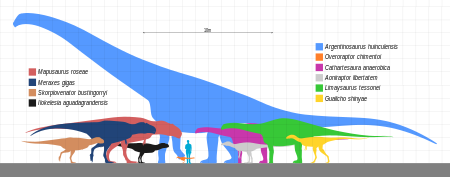Meraxes
| Meraxes Temporal range: Late Cretaceous, (late Cenomanian), ~
| |
|---|---|

| |
| Reconstructed skull | |
| Scientific classification | |
| Kingdom: | Animalia |
| Phylum: | Chordata |
| Clade: | Dinosauria |
| Clade: | Saurischia |
| Clade: | Theropoda |
| Family: | †Carcharodontosauridae |
| Tribe: | †Giganotosaurini |
| Genus: | †Meraxes Canale et al., 2022 |
| Type species | |
| †Meraxes gigas Canale et al., 2022
| |
Meraxes is a genus of carcharodontosaurid theropod dinosaur from the Late Cretaceous Huincul Formation of Argentine Patagonia. The genus contains a single species, Meraxes gigas.[1]
Discovery and naming
The holotype of Meraxes, previously called the "Campanas carcharodontosaurid", MMCh-PV 65, was discovered in 2012.[2] Known bones include a nearly complete skull, pectoral and pelvic elements, partial forelimbs, complete hindlimbs, fragmentary ribs and cervical and dorsal vertebrae, a sacrum, and several complete caudal vertebrae. It has the most complete carcharodontosaurid skeleton known from the Southern Hemisphere.[1]
Meraxes gigas was described in 2022 by Canale et al. based on these remains. The generic name, "Meraxes", honors a dragon from the George R.R. Martin fantasy novel series, A Song of Ice and Fire. The specific name, "gigas", is derived from a Greek word meaning "giant", in reference to its large size.[1]
Description
Meraxes was a very large theropod, weighing approximately 4.26 metric tons (4.70 short tons). Its skull alone is 1.27 m (4.2 ft) long, rivalling that of Acrocanthosaurus which has a skull length of 1.23 m (4.0 ft). The shapes and proportions of various bones (i.e. skull, scapula, metacarpals, ischial shaft, foot, etc.) indicate that Meraxes and Acrocanthosaurus had similar proportions and body size. It also possessed reduced forelimbs, an instance of convergent evolution that occurred independently in four different lineages: Carcharodontosauridae, Abelisauridae, Tyrannosauridae, and Alvarezsauridae.[1]
Osteohistological analysis of the holotype suggests the individual could have been up to 53 years old when it died, having reached skeletal maturity approximately 4 years prior to its death, making it the longest-lived non-avian theropod currently known. Meraxes was also determined to have grown to large size by extending its growth period (hypermorphosis), rather than increasing its relative growth rate (acceleration) through development as in Tyrannosaurus, to which it was compared.[1][2]
Classification
Meraxes represents the earliest diverging member of the tribe Giganotosaurini within the Carcharodontosauridae. The cladogram below displays the results of the phylogenetic analysis by Canale et al.[1]
| Carcharodontosauridae |
| |||||||||||||||||||||||||||||||||||||||||||||||||||||||||
Paleoenvironment

The fossil remains of Meraxes were recovered from the Huincul Formation. A substantial number of taxa are known to have inhabited this paleoenvironment. The theropods of the area are represented by the paravian Overoraptor, the elaphrosaurine Huinculsaurus, the abelisaurs Skorpiovenator, Tralkasaurus, and Ilokelesia, the fellow giant carcharodontosaurid Mapusaurus, and the megaraptoran Aoniraptor.[3][4] However, Meraxes was found in an older rock layer than Mapusaurus, so they probably did not coexist.[1] The herbivores of the area are represented by the rebbachisaurid sauropods Cathartesaura and Limaysaurus, the titanosaurs Argentinosaurus and Choconsaurus, and indeterminate iguanodonts.[5][6]
References
- ^ a b c d e f g Canale, J.I.; Apesteguía, S.; Gallina, P.A.; Mitchell, J.; Smith, N.D.; Cullen, T.M.; Shinya, A.; Haluza, A.; Gianechini, F.A.; Makovicky, P.J. (7 July 2022). "New giant carnivorous dinosaur reveals convergent evolutionary trends in theropod arm reduction". Current Biology. doi:10.1016/j.cub.2022.05.057. PMID 35803271.
- ^ a b Cullen, Thomas M.; Canale, Juan I.; Apesteguía, Sebastián; Smith, Nathan D.; Hu, Dongyu; Makovicky, Peter J. (25 November 2020). "Osteohistological analyses reveal diverse strategies of theropod dinosaur body-size evolution". Proceedings of the Royal Society B: Biological Sciences. 287 (1939): 20202258. doi:10.1098/rspb.2020.2258. PMC 7739506. PMID 33234083. S2CID 227154091.
- ^ Matías J. Motta; Federico L. Agnolín; Federico Brissón Egli; Fernando E. Novas (2020). "New theropod dinosaur from the Upper Cretaceous of Patagonia sheds light on the paravian radiation in Gondwana". The Science of Nature. 107 (3): Article number 24. Bibcode:2020SciNa.107...24M. doi:10.1007/s00114-020-01682-1. hdl:11336/135530. PMID 32468191. S2CID 218913199.
- ^ Cerroni, M.A.; Motta, M.J.; Agnolín, F.L.; Aranciaga Rolando, A.M.; Brissón Egli, F.; Novas, F.E. (2020). "A new abelisaurid from the Huincul Formation (Cenomanian-Turonian; Upper Cretaceous) of Río Negro province, Argentina". Journal of South American Earth Sciences. 98: 102445. doi:10.1016/j.jsames.2019.102445. S2CID 213781725.
- ^ Calvo, J. O. and Salgado, L. (1995). "Rebbachisaurus tessonei sp. nov. A new sauropod from the Albian-Cenomanian of Argentina; new evidence on the origin of the Diplodocidae." Gaia, 11: 13-33.
- ^ Baiano, Mattia; Coria, Rodolfo; Cau, Andrea (2020). "A new abelisauroid (Dinosauria: Theropoda) from the Huincul formation (lower upper Cretaceous, Neuquén Basin) of Patagonia, Argentina". Cretaceous Research. 110: 104408. doi:10.1016/j.cretres.2020.104408. S2CID 214118853.
Error: "Q112966897" is not a valid Wikidata entity ID.
Error: "Q112969374" is not a valid Wikidata entity ID.
- Articles with short description
- Use dmy dates from July 2022
- Articles with 'species' microformats
- Taxonbars desynced from Wikidata
- Taxonbar pages requiring a Wikidata item
- Taxonbars with invalid from parameters
- Taxonbars with multiple manual Wikidata items
- Taxonbars without secondary Wikidata taxon IDs
- Carcharodontosaurids
- Cenomanian life
- Cretaceous Argentina
- Fossil taxa described in 2022
- Fossils of Argentina
- Huincul Formation
- Late Cretaceous dinosaurs of South America
- Turonian life
















